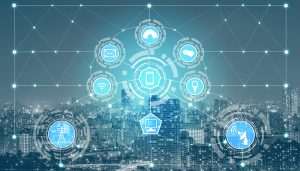 Market Connections conducted their annual Federal Media and Marketing Study and released the findings at a breakfast event on Halloween serving up a number of treats for those involved in marketing to the Federal government (it also happened to be the morning after the Washington Nationals won the World Series, so the crowd at the DC event was in a jovial mood despite being sleep deprived). This annual survey aims to take the pulse of the media habits of those involved in buying decisions (whether they be decision makers or influencers) in the Federal government. Each year the survey looks at where Federal decision makers turn to get information related to their job and also looks at how they consume media more generally for their personal lives.
Market Connections conducted their annual Federal Media and Marketing Study and released the findings at a breakfast event on Halloween serving up a number of treats for those involved in marketing to the Federal government (it also happened to be the morning after the Washington Nationals won the World Series, so the crowd at the DC event was in a jovial mood despite being sleep deprived). This annual survey aims to take the pulse of the media habits of those involved in buying decisions (whether they be decision makers or influencers) in the Federal government. Each year the survey looks at where Federal decision makers turn to get information related to their job and also looks at how they consume media more generally for their personal lives.
This year's survey found that event attendance is holding steady, as it has for several years, and even growing in some areas. One reason for the steady event performance may be the Feds trust in associations. Sixty percent of respondents show a high trust in professional organizations. Peers and colleagues come in a close second, with 57% trusting them as key sources of information. Events, especially those backed by a professional organization, give Federal decision makers a trusted place to interact with their fellow workers to get needed information.
Webinar attendance is increasing, with 78% of people who "attend" webinars doing so in real-time. Another 47% report watching recorded webinars during the workday. The best time to host these webinars? Anytime before 2:00PM works well with the 11:00AM to 2:00PM time block being the most preferred.
Podcasts are also gaining in mindshare in the Federal market with 48% saying they listen. However, the majority of those respondents listen to podcasts for pleasure rather than work (68% vs 32%). Also, when listening to podcasts, the majority of people (48%) skip the ads embedded within them.
In terms of what respondents want to hear, whether it is an event, webinar, or podcast, the survey found that appealing to Federal decision makers as people first rather than potential consumers of a product or service has the greatest impact. The survey found that the biggest concerns of this group were around employee morale and recruiting employees as well as funding and budget issues. They are interested in hearing how work can be made better both from a financial efficiency perspective and a day-to-day employee experience perspective.
This connection to the employee experience can impact who you invite to attend and speak at events. The panel discussion that followed the survey results talked about reaching out to the high ranking C-suite officials and continuing to invite them to attend and speak but also asking them, "who are you mentoring in your organization?" and "who else in your organization would be a great speaker or resource on this topic?" By helping Feds cultivate and showcase talent in their organization, companies can begin to earn that "trusted partner" moniker so many aspire to achieve.
For more results of the survey, visit Market Connections.



 It is called the Internet of Things (IoT) - plural - for a reason. IoT encompasses everything from traditional IT devices like laptops and phones to next-generation technologies like virtual assistants (Alexa, Google Home) to previously unconnected technologies like TVs to everyday utilities like HVAC systems and even refrigerators. With this wide range of things, agencies are finding it difficult to catalog every IoT device, making the creation of policies and processes even more challenging.
It is called the Internet of Things (IoT) - plural - for a reason. IoT encompasses everything from traditional IT devices like laptops and phones to next-generation technologies like virtual assistants (Alexa, Google Home) to previously unconnected technologies like TVs to everyday utilities like HVAC systems and even refrigerators. With this wide range of things, agencies are finding it difficult to catalog every IoT device, making the creation of policies and processes even more challenging. We've written here about how the government is looking at
We've written here about how the government is looking at  Robotic Process Automation (RPA). It may sound like a premise to a movie where robots take over the world, but it's very real and it's helping organizations realize modernization goals. Despite the name, RPA has nothing to do with robots. It is about software that uses artificial intelligence (AI) to automate high-volume, repetitive tasks. This
Robotic Process Automation (RPA). It may sound like a premise to a movie where robots take over the world, but it's very real and it's helping organizations realize modernization goals. Despite the name, RPA has nothing to do with robots. It is about software that uses artificial intelligence (AI) to automate high-volume, repetitive tasks. This  With another Government Fiscal Year ramping up, we're starting with a whole new year of budget and contract opportunities in the government market. As we've written here before, the acquisition and procurement process in government is evolving to adapt to the
With another Government Fiscal Year ramping up, we're starting with a whole new year of budget and contract opportunities in the government market. As we've written here before, the acquisition and procurement process in government is evolving to adapt to the 
